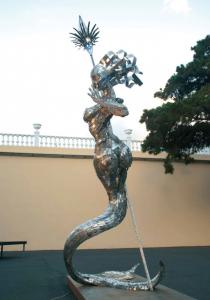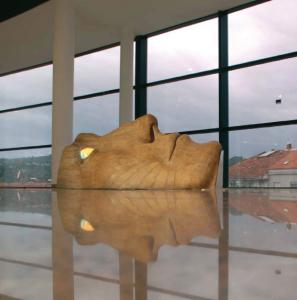Metal Skin
Rambling on the streets of the Gothic Quarter in Barcelona, it is not usual that a two- and a half-meter-high stainless steel dancer is leaning over us. However, if some meters further a Mermaid from a sci-fi film is staring at us, we can be sure, that we have approached an exhibition which cannot be ignored.

Rambling on the streets of the Gothic Quarter in Barcelona, it is not usual that a two- and a half-meter-high stainless steel dancer is leaning over us. However, if some meters further a Mermaid from a sci-fi film is staring at us, we can be sure, that we have approached an exhibition which cannot be ignored.

After seeing Gaudí’s art nouveau buildings in the medieval Gothic Quarter, Julio Nieto’s sculptures have a strange, unearthly effect. The works seem to be alien in the city’s crowd. Not just due to their sizes and lighting, but with their brittle substance use, armour-like but facile-looking „skins”, and with their energetic bodies, which are imitating a never ending motion. However, the installation of Coerographia and La Llamada in front of the building Pia Almoina is not just a gimmick, but the substantive summary of the travelling exhibition, Metal Skin, street sculpture.
The exhibition is a result of a five years work of Julio Nieto. It consists nine large statues, and between 2008 and 2012 it was displayed on the streets in the Canary Islands and in Spain. The aim of installing these artworks on the streets was to address everyone, and let the message of the statues reach everybody, to initiate communication among the passers-by. The purpose of the project is to rediscover the public area as the ideal location to popularize multicultural coexistence.

Although these are basically outdoor sculptures, the exhibition was available this year in galleries and museums all over Europe as well. The current exhibition place, the Museu Diocesá de Barcelona is mostly appropriate from a touristic point of view, otherwise the gothic building and the museum’s core material, the medieval altarpieces and lithurgical supplies are quite incompatible with Nieto’s themes and substance use – although next to hundred-year-old works the sculptures of the artist look more vivid.
In the museum’s first floor room we can see Marea, the woman made of fishes, while on the opposite side we see Viajero and the Vida extraterrestre. These statues are not on a pedestal, the last two are lying in front of the visitors, and look as if they were really alluding to an alien intelligence, an uneartlhy experience. Viajero’s face is huge and in his glance reflects the Blue planet – he is the scientist, who has travelled all around the world, but could not find anything, so he is prepared to conquer the sky –, and by looking at the Vida extraterrestre, we can easily associate to the scene from the movie Prometheus (2012), when the research team finds a large head, which is identified as the Creator – as if Nieto has created the ancestress’s head. This work is cold and steel – as if it would be a testimony of a bygone civilization or the remains of a more intelligent being which had lived here once.

This still, „memento”-nature is missing from the rest of the artworks. Instead, the movement, the pulse of life appears. It is interesting to see that such a cold and lifeless material as stainless steel is capable of expressing a surface, a movement and the character of a living organism.

The effect of the tales and film industry is felt in the huge cat of Y Alicia. The title and the cat’s wild smile is a clear reference to the story Alice in Wonderland. The most impressive thing about the sculpture is that it shows a generous, supple movement of the cat’s body, while it also shows small, instantaneous changes – we almost feel the electricity that runs through the body of the animal, and bristles the hairs on its back.

The Enamorado de acero can be described by dynamic – balance, movement – permanence, instantaneous – timeless, solid – permeable, rigid - lively opposites. The artist just came to a standstill, but in his artistic and permanent symmetry we also feel the energy of the movement. The idealized steel body shows an illusion of a three-dimensional body, but there is a heart shaped hole in the man’s chest. Nieto displays love with the lack of material, this way expressing the dissonance of the emotional and physical phenomena.

The sculpture, ?Por Qué me echaron del cielo? is also built on the body-spirit contrast, but this opposition is not only expressed by the use of material and by the lack of material (the head of the bronze statue is like a basket, in which as organic material appear some apples), but also by the dynamics of the statue and in the relationship of heavy and weightless. The body and the wings of the angels seem so light: the body is not heavy because of the steel, but because of its thoughts, symbolized by the fruits. The spirit makes you really alive, but its weight can be heavier than metal. The apple – especially next to the metal – can be interpreted as the symbol of vitality. In the Bible, the apple is an instrument of fall and the knowing of forbidden love, but here it appears as the reference of sensuality and bodily desires. The „fallen angel” in this case is not Lucifer, but a thoughtful being. Nieto highlighted sensuality by putting a (according to a Bible) sexless angel into the shape of a nude female body, he has also emphasised sensuality. By the way, the mysticists of the Middle Ages discovered a Pentagon in the cross-section of the apple’s core, so for them the apple was the symbol of the sensual spirit hidden in the matter.

The freedom of movement and boundless dynamism is reflected in the statue Ícaro Salvado. Nieto changes the history of Greek mythology: he imagines a joyful, happy sequel instead of the tragic fate of the boy. The artist perhaps displays the moment after the landing: the hero’s wing was broken during the trip, but it seems as if the successful landing and the fact that he ran away from island Knossos motivate a boy to fly again. Nieto expresses the sense of the flight’s freedom in the movement of running. We witness again that soaring is not dependent on physical features.
Julio Nieto is almost completely unknown in Hungary, however, his artistic activities include sculpture, design, performance art, poetry and installation. In his current exhibition the works have some kind of sci-fi and high-tech nature. His topics draw on Greek mythology but their essential element is movement and life. His previous series, the Kamasutra del Aira consist of small statues, and in every piece a man and a woman merge in one motion. Unfortunately, they couldn’t be issued at the current exhibition place due to their erotic intonation.
Julio Nieto: Metal Skin
Galleries Villa del Arte, in the building of the Museu Diocesà of Barcelona
2013. 09. 27 – 2014. 01. 12



Facebook-hozzászólások